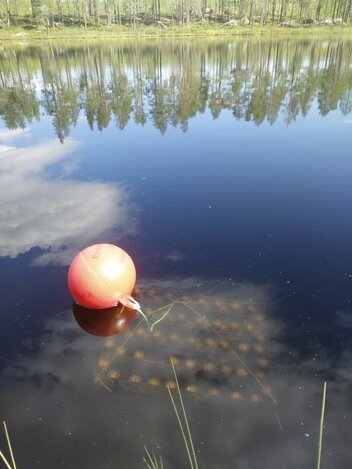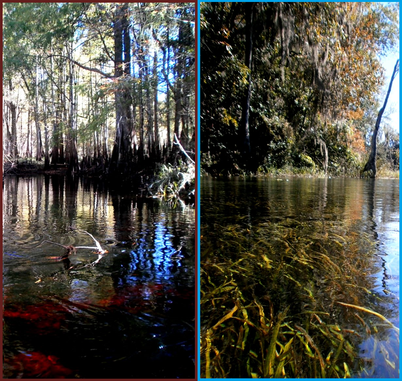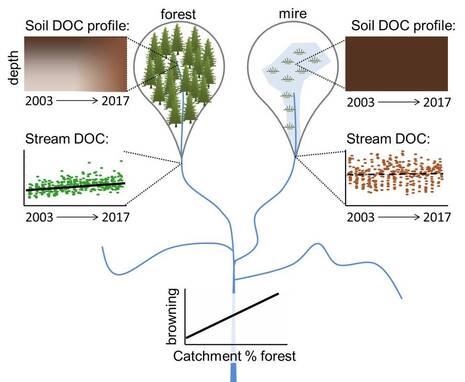Patterns of change and ecological effects of dissolved organic matter in lakes and rivers
|
What are the proximate drivers of heterogeneity in browning trends among boreal streams?
In lakes and rivers throughout the north, concentrations of dissolved organic carbon (DOC) have been increasing over the last few decades, caused in part by anthropogenic changes to the land and atmosphere. This "brownification" of inland waters has a number of potential consequences for ecology, water quality, and landscape carbon budgets. Working with data from the Krycklan Catchment Study in northern Sweden, I have linked differences in the long-term dissolved organic carbon trends among streams to differences in the behavior of the two main sources of DOC in the boreal landscape: mire peats and forest soils. Forest soils have shown an increase in DOC concentrations over time, particularly in deeper layers, while DOC in the porewater of mires has not changed over time. Throughout the network, differences in the proportion of these two sources drive the magnitude of browning and changes in organic carbon flux among streams. Fork et al. 2020. Water Resources Research. |
 A nutrient diffusing substrate deployment in a lake in boreal northern Sweden.
A nutrient diffusing substrate deployment in a lake in boreal northern Sweden.
.
How do light limitation and nutrient delivery by DOM interact to modulate the growth and function of benthic biofilms in lakes?
Some of my current research contributes to a large, multidisciplinary research project with the aim of assessing and understanding the resilience and vulnerability of northern lakes to climate change. One of the many ways that climate change and more broadly, global change, can impact freshwaters is long-term increases in dissolved organic matter (DOM). As a postdoctoral researcher at the Climate Impacts Research Center at Umeå University, I am asking how differences in water column DOM concentrations among arctic and boreal lakes in northern Sweden affect benthic communities' growth and function, including primary production and N cycling. In lakes with clear water, small increases in DOM may have a fertilization effect for pelagic primary producers in these N-limited lakes, but in lakes with darker, DOM rich water, its absorption of light inhibits primary production. My work investigates how water column DOM in northern Swedish lakes affects the growth of benthic algae and the sources of N (mineralization of organic N vs. N2-fixation) they may use. As DOM concentrations in lakes throughout the far north increase (Monteith et al. 2007), this will contribute to better understanding and predictions for C and N cycles in these widespread ecosystems and how they may be altered over the next century of global change.
Fork et al. 2020. Limnology & Oceanography Letters
How do light limitation and nutrient delivery by DOM interact to modulate the growth and function of benthic biofilms in lakes?
Some of my current research contributes to a large, multidisciplinary research project with the aim of assessing and understanding the resilience and vulnerability of northern lakes to climate change. One of the many ways that climate change and more broadly, global change, can impact freshwaters is long-term increases in dissolved organic matter (DOM). As a postdoctoral researcher at the Climate Impacts Research Center at Umeå University, I am asking how differences in water column DOM concentrations among arctic and boreal lakes in northern Sweden affect benthic communities' growth and function, including primary production and N cycling. In lakes with clear water, small increases in DOM may have a fertilization effect for pelagic primary producers in these N-limited lakes, but in lakes with darker, DOM rich water, its absorption of light inhibits primary production. My work investigates how water column DOM in northern Swedish lakes affects the growth of benthic algae and the sources of N (mineralization of organic N vs. N2-fixation) they may use. As DOM concentrations in lakes throughout the far north increase (Monteith et al. 2007), this will contribute to better understanding and predictions for C and N cycles in these widespread ecosystems and how they may be altered over the next century of global change.
Fork et al. 2020. Limnology & Oceanography Letters

On the left: The blackwater Withlacoochee River has dark-colored water resulting from high concentrations of terrestrially-derived DOC that limits the penetration of light in the water column. On the right: The extremely clear water of spring-fed rivers like the Rainbow River allows highly productive, dense plant communities to grow on the river bottom.
|
How does water column dissolved organic matter affect riverine nitrogen cycling?
In my master's research at Florida International University, I asked how the concentration of dissolved organic matter (DOM) in a river's water column affects denitrification in the benthic sediments. Denitrification is a microbial process that requires organic matter as a substrate in order to reduce nitrate into a gaseous form (N2O or N2). One might expect that DOM could act as fuel for denitrifying bacteria, but I found that denitrification tends to be carbon limited in rivers with higher concentrations of DOM. Not all DOM is created equal - my research suggests that denitrification in high DOM rivers may be carbon-limited because light absorption by DOM prevents the growth of benthic plants in these rivers and thereby limits labile carbon to the benthic sediments in the form of root exudates. Fork & Heffernan. 2014. Ecosystems |

